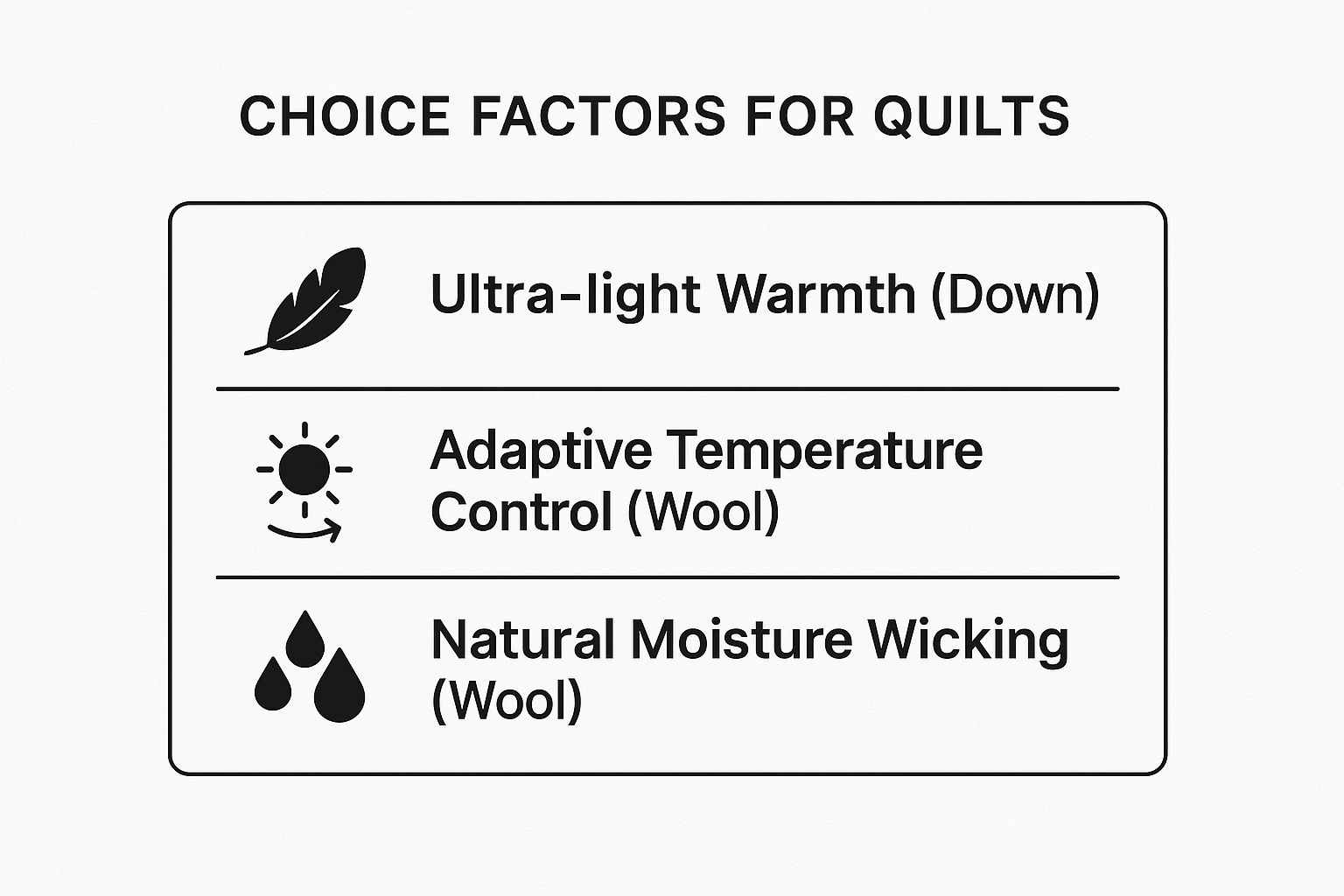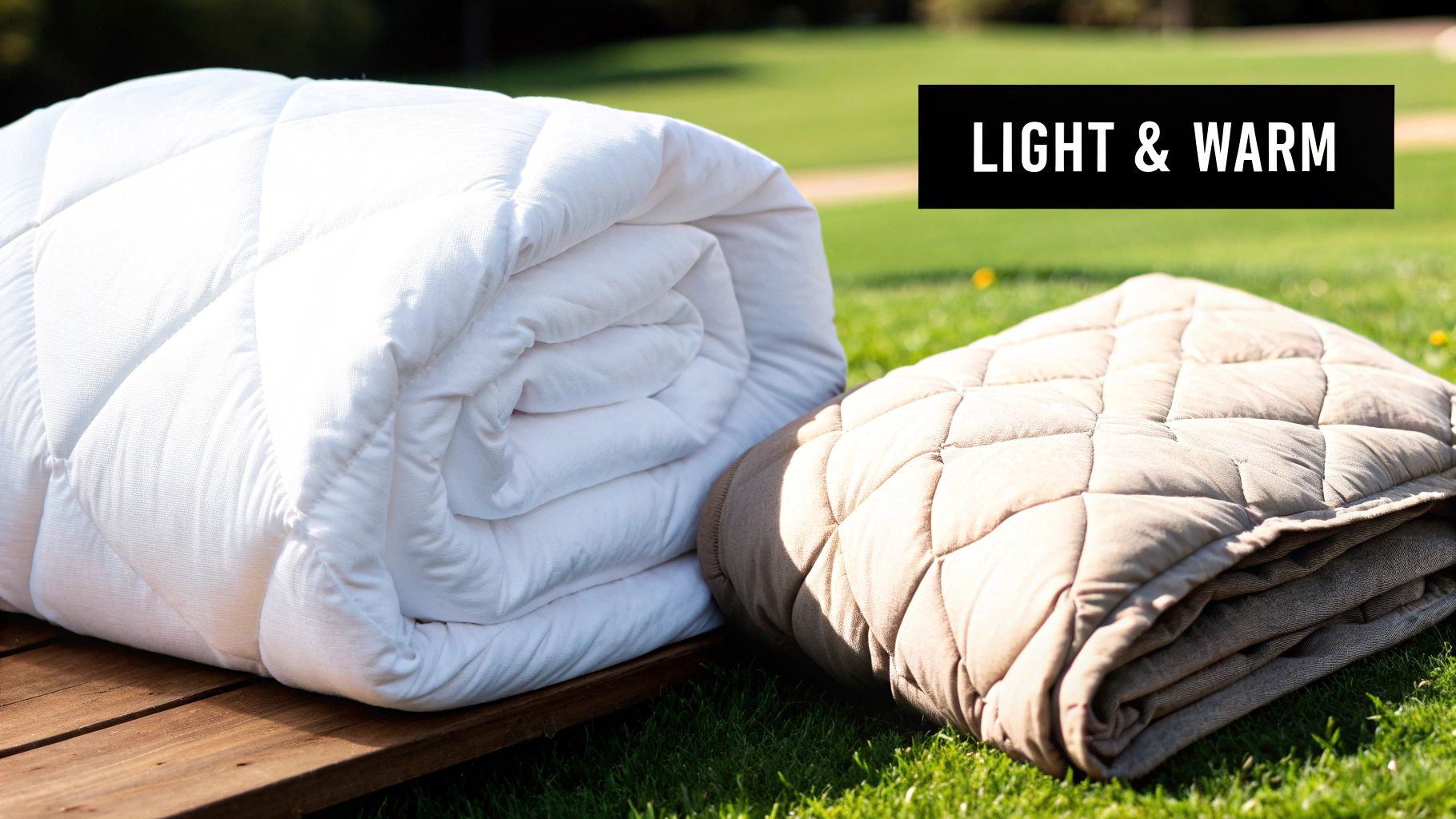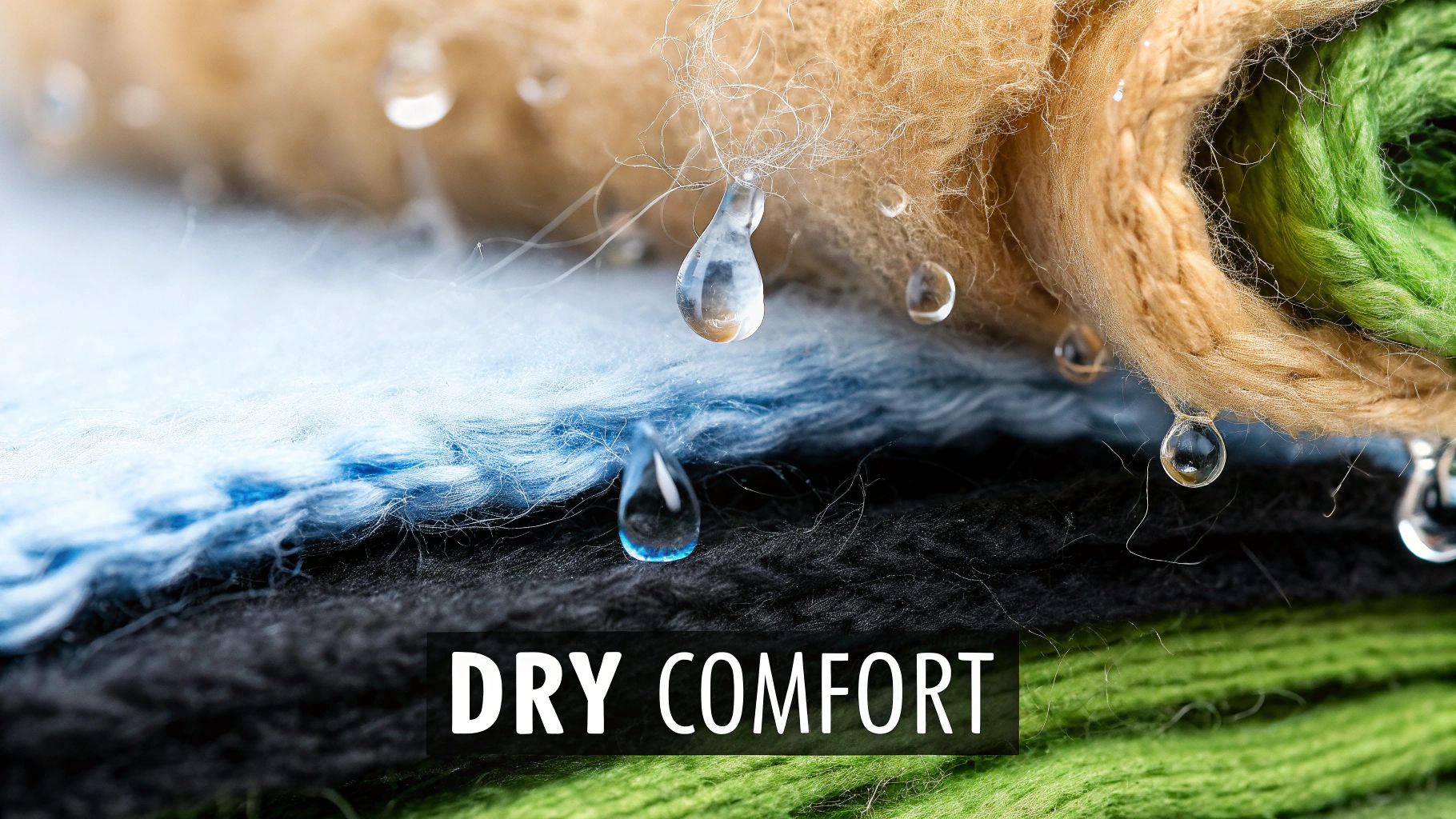Struggling to choose the perfect quilt? The down vs wool quilt debate comes down to one simple question: do you crave cloud-like warmth or adaptive, breathable comfort? Down is a champion insulator, trapping air to keep you incredibly warm with minimal weight. Wool, however, is a natural temperature regulator, brilliant at wicking away moisture to keep you comfortable and dry all night long.
This guide cuts through the fluff. We'll give you practical, real-world comparisons to help you decide which material will truly transform your sleep.
Choosing Your Perfect Quilt
Picking between a down and a wool quilt is one of the most important decisions for your sleep quality. This isn't just another layer on the bed; it's about creating the perfect microclimate that lets your body rest and recharge. Each natural fibre offers unique benefits suited for different sleepers and climates.
We’ll put them head-to-head, focusing on how they perform night after night.
- For the Cold Sleeper: Always reaching for an extra blanket? Down's unmatched insulation-to-weight ratio delivers serious warmth without weighing you down.
- For the Hot Sleeper: Tend to wake up too warm or a bit sweaty? Wool's ability to breathe and manage moisture is a game-changer.
- For Couples: Finding a quilt for two different body temperatures is tough. Wool is a fantastic compromise, working to regulate the temperature for both partners.
This infographic breaks down the key strengths that set these quilts apart.

Your decision should be driven by your biggest sleep challenge—whether that’s fighting the chill, staying cool and dry, or finding a happy medium for two.
To make it even clearer, let’s look at a side-by-side comparison.
Down vs Wool Quilts: A Quick Comparison
This table summarises the core differences, helping you see at a glance which one might be right for you.
| Feature | Down Quilt | Wool Quilt |
|---|---|---|
| Primary Benefit | Exceptional warmth-to-weight ratio; feels light and lofty. | Superior temperature and moisture regulation; keeps you dry. |
| Best For | Cold sleepers and those who prefer a lightweight feel. | Hot sleepers, couples, and those in humid climates. |
| Breathability | Good, but primarily focused on insulation and trapping heat. | Excellent; actively wicks moisture away from the body. |
| Hypoallergenic | High-quality down is purified to be hypoallergenic. | Naturally hypoallergenic and resistant to dust mites, mould, and mildew. |
| Durability | Very long-lasting (10+ years) with proper, careful maintenance. | Extremely durable and resilient; maintains structure well over time. |
| Care | Often requires professional cleaning to protect the delicate clusters. | Typically requires airing and spot cleaning; some are machine washable. |
With these key distinctions in mind, you're better equipped to match a quilt to your specific sleep needs. Now, let's dive deeper into each of these points.
Comparing Down vs Wool Quilt Warmth and Weight
When you're settling the down vs wool quilt debate, it's not as simple as picking the thickest option. The real magic is in how each material traps air and manages your body heat.
Down and wool are fantastic natural insulators, but they work in completely different ways. Down's brilliance is its incredible loft, while wool's superpower lies in its smart, adaptive fibres.

Down: The Champion of Lightweight Warmth
Down insulation traps thousands of tiny pockets of air using the soft, fluffy clusters found beneath the feathers of geese or ducks. Your body heat warms this trapped air, creating a cocoon of warmth.
The quality of this insulation is measured by fill power. A higher fill power means larger, loftier down clusters that trap more air, providing more warmth with less weight. To learn more, our ultimate guide to a goose feather and down quilt explains how this leads to a better night’s sleep.
This efficiency gives a high-quality down quilt its signature weightless, cloud-like feeling while delivering exceptional warmth.
Wool: The Smart Temperature Regulator
Wool works differently. It doesn't just trap heat; it actively regulates the temperature around you. Each wool fibre has a natural crimp that creates a springy, breathable matrix. But wool’s secret weapon is its ability to absorb and release moisture.
A single wool fibre can absorb up to 30% of its own weight in moisture before it even feels damp. This unique property stops that clammy feeling you get from overheating, making it a fantastic choice for managing temperature swings throughout the night.
A Real-World Sleeper Comparison
Let's see how these differences play out for two different people.
-
Case Study 1: The Cold Sleeper Who Hates Heavy Blankets
Imagine Sarah. She lives in a cold climate and feels the chill at night but can't stand being weighed down by heavy bedding. A high-fill-power down quilt is her perfect solution. It offers the serious insulation she needs while its feather-light feel means she never feels trapped. -
Case Study 2: The Hot Sleeper Prone to Overheating
Now, think about Tom. He often wakes up in a sweat. A down quilt would likely trap too much heat for him. A wool quilt, on the other hand, is ideal. As his body temperature rises, the wool fibres wick moisture away, preventing overheating and keeping him comfortable all night.
This gets to the heart of the difference: Down offers maximum warmth for minimum weight, while wool delivers balanced, breathable warmth that works with you.
Analysing Breathability and Moisture Control
Ever woken up feeling clammy or too warm? Your quilt is often the culprit. This is where the down vs wool quilt debate really matters, because each material handles airflow and moisture differently.
Wool is a natural performance fibre. Its ability to manage moisture is second to none, actively pulling humidity and sweat away from your skin to keep you dry.
Down, on the other hand, is a master insulator. Its main job is trapping warm air. The downside is that if you perspire, down can trap that moisture along with the heat, causing the delicate clusters to clump and lose their insulating power.

Wool: The Active Moisture Manager
Think of a wool quilt as a smart, breathable shield. As your body naturally releases moisture, the wool fibres absorb it, preventing that sticky, uncomfortable feeling.
This makes wool a hero in several key situations:
- For Hot Sleepers: Wool helps vent excess heat and wicks away sweat, keeping you cooler and drier.
- For Humid Climates: Wool’s ability to draw moisture from the air and your body prevents the bed from feeling damp.
- For Couples: Wool is a fantastic mediator, wicking moisture away from the warmer partner while ensuring cosy warmth for the cooler one.
Understanding the science behind breathable fabrics and sleep shows how much a material like wool can improve your rest.
Down: The Breathable Insulator
To be clear, a good quality down quilt is still very breathable. Air moves freely through the lofty clusters, which is why you don’t get that stifling feeling common with dense synthetic quilts.
Where it differs from wool is in moisture management. It’s a more passive system, relying on airflow to carry moisture away rather than actively pulling it from your skin. This is why down is at its best when sweat and humidity aren't your main problems.
Practical Use Cases: Head-to-Head
Let’s apply this to real-world scenarios.
Scenario A: The Humid Summer Night
On a sticky summer night in Brisbane, a wool quilt is your best friend. It will actively pull humidity from the air and away from your skin. A down quilt would likely trap that warm, humid air, becoming uncomfortably clammy.
Scenario B: The Cold, Dry Winter Night
Now, imagine a crisp winter’s night in Canberra. This is where a down quilt shines. The main job is to trap body heat, and since the air is dry, you're not worried about sweating. Down gives you incredible insulation without the weight.
Ultimately, the best choice for breathability comes down to your personal climate—both in your bedroom and outside your window.
Allergies, Health, and Your Quilt: A Practical Guide
If you're prone to allergies, choosing a quilt is a health decision. Many people think they're allergic to down, but the real culprit is often dust mites, mould, or residual dust in poorly cleaned, low-quality down.
This is a crucial distinction. It means a high-quality down quilt isn't automatically off-limits for allergy sufferers.

The Myth of the Down Allergy
A true feather allergy is rare. High-quality down goes through an intensive purification process—it's washed, sterilised, and de-dusted multiple times to remove potential allergens. This makes the fill incredibly clean and hypoallergenic.
When shopping, look for labels that say hypoallergenic or mention purification standards. That’s your sign that the fill has been meticulously processed to be safe for most people.
Wool: A Natural Allergen Deterrent
While top-tier down is made safe, wool is naturally designed to resist allergens. Its secret weapon is moisture management. Wool fibres create a dry environment where common allergens simply can't thrive.
- Dust Mites: These tiny critters need humidity to live. Wool’s dry microclimate is an inhospitable environment for them.
- Mould and Mildew: They need moisture to grow. By keeping your bedding dry, wool naturally stops them.
This makes wool a fantastic choice for anyone with asthma or respiratory sensitivities. See how wool compares in our guide to the top 7 hypoallergenic bedding materials.
Research from the University of Sydney found that wool bedding can promote a more restful sleep, partly due to its superior temperature and moisture regulation, which contributes to a healthier sleep environment.
A Real-World Health Scenario
Imagine someone with mild asthma who regularly wakes up congested. Their first thought might be to blame their old quilt. Swapping to a wool quilt could dramatically improve their symptoms. By actively managing humidity, the wool reduces the presence of dust mites and mould spores, leading to clearer airways and better sleep.
Similarly, choosing a high-quality, properly purified down quilt could offer the same relief—proving that the solution lies in quality, not just the material itself.
Durability, Care, and Finding the Best Long-Term Value
A good quilt is an investment in your sleep. When weighing a down vs wool quilt, you’re not just looking at the price tag—you're considering its entire lifespan and the effort it requires.
A well-cared-for down quilt can last over a decade. The secret is protecting its delicate clusters. Wool is a true workhorse, with naturally crimped fibres that resist flattening and bounce back beautifully, giving it a solid lifespan of 10-15 years.
The Realities of Quilt Care
This is where the two materials truly differ.
Caring for a Down Quilt
With a down quilt, everything comes down to preserving its loft. Harsh washing can damage the delicate clusters.
- Daily Care: A gentle shake each morning is usually all it takes to fluff it back up.
- Washing: Professional laundering is often the safest route. One wrong move with washing or drying can ruin your quilt.
- Drying: Down must be dried completely on a low heat setting, which can take several hours. Even a hint of moisture can lead to mould.
Our essential guide on how to wash and care for down quilts breaks it down into simple, step-by-step instructions.
Caring for a Wool Quilt
Wool is remarkably low-maintenance. Thanks to natural lanolin, it repels dirt, and its moisture-wicking ability prevents bacteria and odours.
- Regular Care: Air it out on a dry, breezy day for a few hours every couple of months to refresh the fibres.
- Cleaning: Spot cleaning is generally all that's needed for small spills.
- Machine Washing: Check the care label. Some modern wool quilts can be machine washed on a gentle, cool wool cycle with a special detergent. Avoid hot water at all costs.
Long-Term Value: A Practical Comparison
Let's look at the true cost of ownership over 10 years.
Scenario 1: The Busy Professional
Alex has a hectic schedule and no time for complicated laundry. A wool quilt is the clear winner. The care routine—airing it out a few times a year—fits perfectly into a packed schedule.
Scenario 2: The Meticulous Homeowner
Jamie loves investing time in high-quality belongings. A down quilt is a great fit. Jamie sees the annual trip to the professional cleaners as a worthwhile investment to ensure the quilt stays lofty and warm for over a decade.
At the end of the day, wool offers simple durability. Down rewards extra care with exceptional longevity.
Understanding Sustainability and Ethical Sourcing
When you’re choosing a down vs wool quilt, you're also making a choice about sustainability and ethics.
Wool is a champion of renewability. Sheep are shorn annually for their own health, making wool a resource that keeps on giving. It’s also completely biodegradable, returning nutrients to the soil at the end of its life without leaving behind microplastics.
Ethical Considerations for Down
The down industry has faced valid animal welfare concerns. Thankfully, massive strides have been made toward ethical sourcing. The key is to look for certifications.
The most crucial is the Responsible Down Standard (RDS). It’s a global benchmark ensuring that the down and feathers in your quilt come from animals that have been treated with respect.
RDS certification guarantees:
- No live-plucking
- No force-feeding
- Full traceability from farm to finished quilt
By choosing an RDS-certified down quilt, you support a system that puts animal welfare first. It means you can enjoy the incredible warmth of down with a clear conscience. You can also learn about other sustainable options in our list of the top 8 eco-friendly bedding materials for 2025.
Your Top Quilt Questions, Answered
Choosing the right quilt often comes down to a few practical questions. Here are the straight answers to help you decide.
Which Quilt Is Better for Couples?
For couples, wool is almost always the winner, especially if one sleeps hot and the other runs cold. Its ability to regulate temperature creates a balanced microclimate, wicking moisture from the warmer sleeper while keeping the cooler partner cosy.
How Do I Wash My Quilt at Home?
Always check the care tag. Most down quilts require professional cleaning to protect the delicate clusters. Wool quilts generally thrive with regular airing and spot-cleaning; machine washing is risky even if the tag allows it.
Does a Higher Price Mean Better Quality?
Usually, but focus on the specs. With down, a higher price often means a higher fill power (more warmth, less weight) and ethical sourcing (like RDS certification). For wool, the price reflects the grade of wool and its density (GSM). The best value comes from matching the quilt’s features to your specific sleep needs.
Is Down or Wool Better for Hot Sleepers?
Wool is the undisputed champion for hot sleepers. Its moisture-wicking properties and superior breathability regulate your body temperature and prevent overheating. Down is designed to trap heat, which is great for cold sleepers but can easily become too much for someone who runs warm.
Find Your Perfect Sleep Solution
Ready to invest in better sleep? At Sienna Living, we offer a curated collection of premium quilts designed for exceptional comfort. Whether you need the adaptive breathability of wool or the lightweight warmth of down, our range has the perfect fit for you. Explore our collection and transform your sleep tonight.

